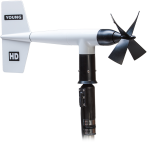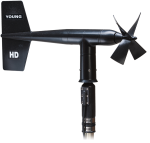
Compatible with all Campbell Scientific data loggers






Overview
The 014A, manufactured by Met One, is a three-cup anemometer that monitors wind speed for the range of 0 to 45 m/s with a threshold of 0.45 m/s. You connect the 014A directly to a Campbell Scientific data logger, which measures the anemometer's pulse signal and converts the signal to engineering units (mph, m/s, knots).
Read MoreBenefits and Features
- Ideal for applications that do not require wind direction measurements
- Sealed magnetic reed switch
- Designed for continuous, long-term, unattended operation in adverse conditions
- Standard aluminum cup assembly has a distance constant of less than 4.5 m
- For greater sensitivity, an optional LEXAN cup assembly has a distance constant of less than 1.5 m
Images



Detailed Description
The 014A is constructed of corrosion-resistant, stainless-steel and anodized aluminum. It's three-cup anemometer assembly contains a sealed magnetic reed switch. Rotation of the cupwheel produces a pulse that is directly proportional to wind speed.
Similar Products
Compatibility
Please note: The following shows notable compatibility information. It is not a comprehensive list of all compatible products.
Data Loggers
| Compatible | Note | |
|---|---|---|
| CR1000 (retired) | ||
| CR1000X (retired) | ||
| CR300 (retired) | ||
| CR3000 (retired) | ||
| CR310 | ||
| CR350 | ||
| CR6 | ||
| CR800 (retired) | ||
| CR850 (retired) |
Additional Compatibility Information
Mounting
The 014A attaches to a Campbell Scientific crossarm using a 1049 Nu-Rail fitting or CM220 Right Angle Mounting Bracket. It also can be attached to the top of our CM110, CM115, and CM120 stainless-steel tripods using the CM216 Sensor Mounting Kit.
Data Logger Considerations
The 014A uses one pulse count channel on the data logger.
Programming
The 014A is read by the PulseCount Instruction in CRBasic and by Instruction 3 (Pulse Count) in Edlog. Wind speed measurements can be taken and processed with any of the data loggers.
Specifications
| Sensor | 3-cup anemometer |
| Measurement Description | Wind speed |
| Range | 0 to 45 m/s (0 to 100 mph) |
| Starting Threshold | 0.45 m/s (1.0 mph) |
| Accuracy | 0.11 m/s (0.25 mph) or 1.5% |
| Contact Rating | 10 mA (maximum) |
| Operating Temperature Range | -50° to +70°C |
| Distance Constant |
|
| Cable Description | Quick-connect connector with vinyl jacketed, shielded cable |
| Radius | 10.4 cm (4.1 in.) |
| Height | 34.8 cm (13.7 in.) |
| Sensor Weight | 318 g (11 oz) |
| Cable Weight | 140 g (5 oz) per 3 m (10 ft) length |
Related Documents
Product Brochures
Manuals
FAQs for
Number of FAQs related to 014A-L: 7
Expand AllCollapse All
-
A replacement reed switch can be ordered. It can be replaced by the user, but Campbell Scientific recommends factory replacement.
-
Replacement sensor cables and bearings can be purchased. They can be replaced by the user, but Campbell Scientific recommends factory replacement.
-
03101-L Specifications
Gust survival: 134 mph (60 m/s)
Accuracy: ±1.1 mph (0.5 m/s)
Threshold (w/ shielded bearings): 1.1 mph (0.5 m/s)
Distance constant: 7.5 ft (63% recovery)014A-L Specifications
Operating range: 0 to 100 mph (0 to 45 m/s)
Accuracy: ±0.25 mph (0.11 m/s) or ±1.5%
Threshold: 1 mph (0.45 m/s)
Distance constant (aluminum cups): 15 ft (4.6 m)
Distance constant (optional fast response Lexan cups): < 5 ft (1.5 m)Any mechanical wind speed sensor will need to have its bearings replaced on a regular basis. The 03101-L is a less expensive sensor and does not have a reed switch to replace. It’s easier to work on, and the bearings are less expensive. The turret covering the bearings is longer and protects the bearings better from dust and debris. The cups and sensor body are plastic and more fragile, so careful handling is required, but they hold up well after the sensor is installed.
The 03101-L comes with a ¾ in. pipe. The 014A-L has a 1 in. pipe.
-
Most Campbell Scientific sensors are available as an –L, which indicates a user-specified cable length. If a sensor is listed as an –LX model (where “X” is some other character), that sensor’s cable has a user-specified length, but it terminates with a specific connector for a unique system:
- An –LC model has a user-specified cable length for connection to an ET107, CS110, or retired Metdata1.
- An –LQ model has a user-specified cable length for connection to a RAWS-P weather station.
If a sensor does not have an –L or other –LX designation after the main model number, the sensor has a set cable length. The cable length is listed at the end of the Description field in the product’s Ordering information. For example, the 034B-ET model has a description of “Met One Wind Set for ET Station, 67 inch Cable.” Products with a set cable length terminate, as a default, with pigtails.
If a cable terminates with a special connector for a unique system, the end of the model number designates which system. For example, the 034B-ET model designates the sensor as a 034B for an ET107 system.
- –ET models terminate with the connector for an ET107 weather station.
- –ETM models terminate with the connector for an ET107 weather station, but they also include a special system mounting, which is often convenient when purchasing a replacement part.
- –QD models terminate with the connector for a RAWS-F Quick Deployment Station.
- –PW models terminate with the connector for a PWENC or pre-wired system.
-
Not every sensor has different cable termination options. The options available for a particular sensor can be checked by looking in two places in the Ordering information area of the sensor product page:
- Model number
- Cable Termination Options list
If a sensor is offered in an –ET, –ETM, –LC, –LQ, or –QD version, that option’s availability is reflected in the sensor model number. For example, the 034B is offered as the 034B-ET, 034B-ETM, 034B-LC, 034B-LQ, and 034B-QD.
All of the other cable termination options, if available, are listed on the Ordering information area of the sensor product page under “Cable Termination Options.” For example, the 034B-L Wind Set is offered with the –CWS, –PT, and –PW options, as shown in the Ordering information area of the 034B-L product page.
Note: As newer products are added to our inventory, typically, we will list multiple cable termination options under a single sensor model rather than creating multiple model numbers. For example, the HC2S3-L has a –C cable termination option for connecting it to a CS110 instead of offering an HC2S3-LC model.
-
The 014A-L sensors use magnets spinning over a mechanical reed switch to sense wind speed. Eventually the mechanical reed switch will fail and will need to be replaced. Replace both the bearings and the reed switch at the same time. For details on replacing bearings and the reed switch, see Appendix C of the instruction manual.
-
Many Campbell Scientific sensors are available with different cable termination options. These options include the following:
- The –PT (–PT w/Tinned Wires) option is the default option and does not display on the product line as the other options do. The cable terminates in pigtails that connect directly to a data logger.
- In the –C (–C w/ET/CS110 Connector) option, the cable terminates in a connector that attaches to a CS110 Electric Field Meter or an ET-series weather station.
- In the –CWS (–CWS w/CWS900 Connector) option, the cable terminates in a connector that attaches to a CWS900-series interface. Connection to a CWS900-series interface allows the sensor to be used in a wireless sensor network.
- In the –PW (–PW w/Pre-Wire Connector) option, the cable terminates in a connector that attaches to a prewired enclosure.
- In the –RQ (–RQ w/RAWS Connector) option, the cable terminates in a connector that attaches to a RAWS-P Permanent Remote Automated Weather Station.
Note: The availability of cable termination options varies by sensor. For example, sensors may have none, two, or several options to choose from. If a desired option is not listed for a specific sensor, contact Campbell Scientific for assistance.






